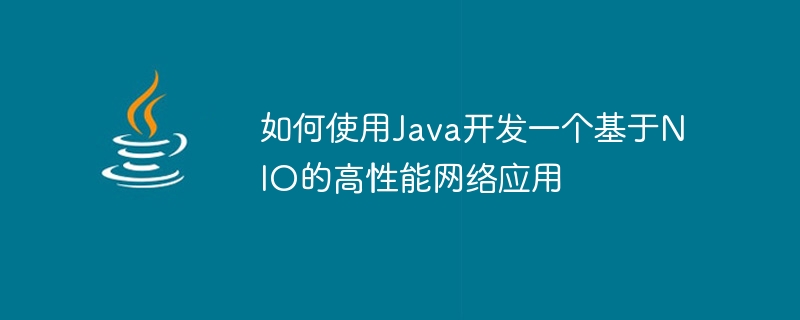Home >Java >javaTutorial >How to use Java to develop a high-performance network application based on NIO
How to use Java to develop a high-performance network application based on NIO
- WBOYWBOYWBOYWBOYWBOYWBOYWBOYWBOYWBOYWBOYWBOYWBOYWBOriginal
- 2023-09-20 15:31:441084browse

How to use Java to develop a high-performance network application based on NIO
Introduction:
With the rapid development of the Internet, the demand for network applications is also growing. The traditional blocking I/O model has poor performance in scenarios with high concurrent access and is prone to request blocking problems. The non-blocking I/O model (NIO) can effectively improve the concurrent processing capabilities of applications. This article will introduce how to use Java to develop a high-performance NIO-based network application and provide specific code examples.
1. Overview of NIO
Java NIO (New Input/Output) is a new I/O model introduced in Java SE 1.4 version. Compared with the traditional blocking I/O model, NIO provides a more efficient non-blocking I/O operation method that can better handle a large number of concurrent connections.
The core components of NIO include: Channel, Buffer and Selector. Channel is used to read and write data, Buffer is used to temporarily store data, and Selector is used to manage multiple Channels to achieve efficient management of multiple Channels by a single thread.
2. Steps to use NIO to develop network applications
-
Create ServerSocketChannel and bind it to the specified port.
The sample code is as follows:ServerSocketChannel serverSocketChannel = ServerSocketChannel.open(); serverSocketChannel.bind(new InetSocketAddress(port)); serverSocketChannel.configureBlocking(false);
-
Create Selector and register ServerSocketChannel to Selector.
The sample code is as follows:Selector selector = Selector.open(); serverSocketChannel.register(selector, SelectionKey.OP_ACCEPT);
-
Waiting for ready events in a wireless loop.
The sample code is as follows:while (true) { selector.select(); Set<SelectionKey> selectedKeys = selector.selectedKeys(); for (SelectionKey key : selectedKeys) { if (key.isAcceptable()) { // 处理Accept事件 } else if (key.isReadable()) { // 处理Read事件 } else if (key.isWritable()) { // 处理Write事件 } selectedKeys.remove(key); } } -
When processing various events, data can be read and written through Channel.
The sample code is as follows:SocketChannel socketChannel = serverSocketChannel.accept(); socketChannel.configureBlocking(false); socketChannel.register(selector, SelectionKey.OP_READ); ByteBuffer buffer = ByteBuffer.allocate(1024); int bytesRead = socketChannel.read(buffer); while (bytesRead != -1) { buffer.flip(); while (buffer.hasRemaining()) { System.out.print((char) buffer.get()); } buffer.clear(); bytesRead = socketChannel.read(buffer); } -
After processing the event, the resources can be released and the Channel can be closed.
The sample code is as follows:if (key.isReadable()) { SocketChannel socketChannel = (SocketChannel) key.channel(); socketChannel.close(); }
3. Summary
This article introduces how to use Java to develop a high-performance network application based on NIO. NIO achieves efficient management of multiple Channels by a single thread through the combination of Channel, Buffer and Selector. Through the demonstration of sample code, we can clearly understand the steps of developing network applications using NIO.
In actual development, we can further optimize the performance of the application, such as using thread pools to handle various events and rational use of Buffers. I hope this article can be helpful to readers when developing high-performance network applications.
The above is the detailed content of How to use Java to develop a high-performance network application based on NIO. For more information, please follow other related articles on the PHP Chinese website!

